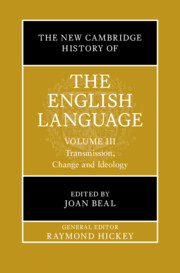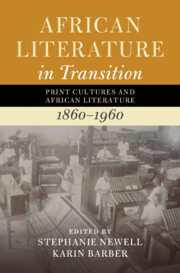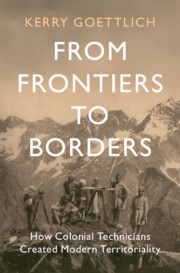Refine search
Actions for selected content:
616278 results in History
Portrait of a Martyr as a Young Man: Social Lives of Photographs in Revolutionary Egypt
-
- Journal:
- Comparative Studies in Society and History , First View
- Published online by Cambridge University Press:
- 24 October 2025, pp. 1-34
-
- Article
-
- You have access
- Open access
- HTML
- Export citation
KEREM TINAZ and OSCAR AGUIRRE-MANDUJANO, eds. Sephardic Trajectories: Archives, Objects, and the Ottoman Jewish Past in the United States (Istanbul: Koç University, 2021). 256 pages. $20.00 paper. ISBN: 9786057685360 – ERRATUM
-
- Journal:
- Review of Middle East Studies , First View
- Published online by Cambridge University Press:
- 24 October 2025, p. 1
-
- Article
-
- You have access
- HTML
- Export citation
Gambling with ocean hazards: interest rates and sea loans in colonial connections (Portugal, 1600–1800)
-
- Journal:
- Revista de Historia Economica - Journal of Iberian and Latin American Economic History , First View
- Published online by Cambridge University Press:
- 24 October 2025, pp. 1-22
-
- Article
-
- You have access
- Open access
- HTML
- Export citation
Benjamin Clough and the birth of Buddhist studies
-
- Journal:
- Journal of the Royal Asiatic Society , First View
- Published online by Cambridge University Press:
- 24 October 2025, pp. 1-21
-
- Article
-
- You have access
- Open access
- HTML
- Export citation
The Sublime Post: How the Ottoman Imperial Post Became a Public Service By Choon Hwee Koh. 272 pp. New Haven, CT, Yale University Press, 2024.
-
- Journal:
- Journal of the Royal Asiatic Society , First View
- Published online by Cambridge University Press:
- 24 October 2025, pp. 1-3
-
- Article
- Export citation
An appropriate technology of breastfeeding in China: 1949–1965
-
- Journal:
- Medical History , First View
- Published online by Cambridge University Press:
- 24 October 2025, pp. 1-21
-
- Article
-
- You have access
- Open access
- HTML
- Export citation
Ku Klux Klan Violence and the Problem of Evidence
-
- Journal:
- Law and History Review , First View
- Published online by Cambridge University Press:
- 24 October 2025, pp. 1-19
-
- Article
-
- You have access
- Open access
- HTML
- Export citation
Women and Sexual Violence in the “1641 Depositions”
-
- Journal:
- Law and History Review , First View
- Published online by Cambridge University Press:
- 24 October 2025, pp. 1-18
-
- Article
-
- You have access
- Open access
- HTML
- Export citation
Cultivating consent: frontier-making and the politics of smallholder subordination in western Turkey’s sweet cherry frontier
-
- Journal:
- New Perspectives on Turkey , First View
- Published online by Cambridge University Press:
- 24 October 2025, pp. 1-22
-
- Article
-
- You have access
- Open access
- HTML
- Export citation
Gender Pay Gap. Vom Wert und Unwert von Arbeit in Geschichte und Gegenwart. Ed. by Wiebke Wiede, Johanna Wolf, and Rainer Fattmann. [Archiv der sozialen Demokratie der Friedrich-Ebert-Stiftung, Reihe: Politik- und Gesellschaftsgeschichte, Bd. 113.] Dietz, Bonn 2023. 287 pp. € 32.00.
-
- Journal:
- International Review of Social History , First View
- Published online by Cambridge University Press:
- 24 October 2025, pp. 1-3
-
- Article
-
- You have access
- HTML
- Export citation
Thomas A. Brady (1937–2025)
-
- Journal:
- Central European History , First View
- Published online by Cambridge University Press:
- 24 October 2025, pp. 1-2
-
- Article
-
- You have access
- HTML
- Export citation
Reconstructing History: Using Language to Estimate Religious Spread
-
- Journal:
- The Journal of Economic History , First View
- Published online by Cambridge University Press:
- 24 October 2025, pp. 1-41
-
- Article
-
- You have access
- Open access
- HTML
- Export citation
Emotions and political legitimacy in eighteenth-century North India: the case of the Afghan text Ḵẖulāṣat ul-Ansāb
-
- Journal:
- Journal of the Royal Asiatic Society , First View
- Published online by Cambridge University Press:
- 24 October 2025, pp. 1-19
-
- Article
-
- You have access
- Open access
- HTML
- Export citation

The New Cambridge History of the English Language
- Transmission, Change and Ideology
-
- Published online:
- 23 October 2025
- Print publication:
- 23 October 2025

African Literature in Transition
- Print Cultures and African Literature, 1860–1960
-
- Published online:
- 23 October 2025
- Print publication:
- 06 November 2025

The Rise and Fall of Turkey's Democrat Party
- The Cold War and Illiberalism, 1945–60
-
- Published online:
- 23 October 2025
- Print publication:
- 06 November 2025

Institutional Change and Property Rights before the Industrial Revolution
- Wardship in Britain, 1485–1660
-
- Published online:
- 23 October 2025
- Print publication:
- 06 November 2025

In the Shadow of the Vatican
- Texan Evangelical Missionaries in Cold War Italy
-
- Published online:
- 23 October 2025
- Print publication:
- 06 November 2025

From Frontiers to Borders
- How Colonial Technicians Created Modern Territoriality
-
- Published online:
- 23 October 2025
- Print publication:
- 06 November 2025
Note on Toponyms, Gender, and Calendar
-
- Book:
- The Kuroshio Frontier
- Published online:
- 11 October 2025
- Print publication:
- 23 October 2025, pp xv-xvi
-
- Chapter
-
- You have access
- Open access
- HTML
- Export citation
